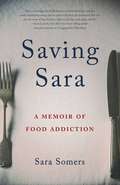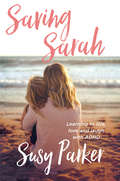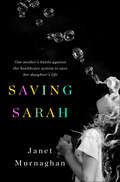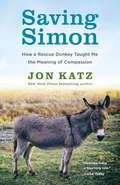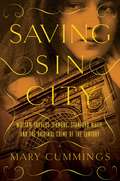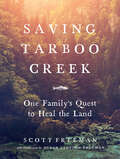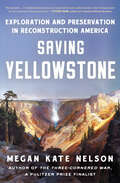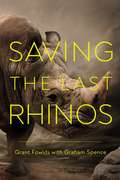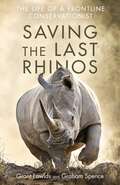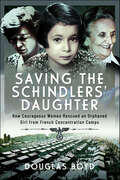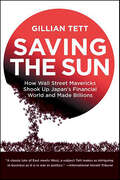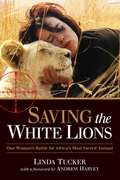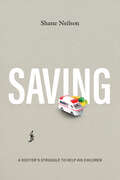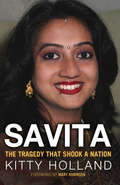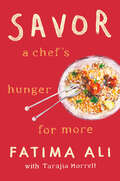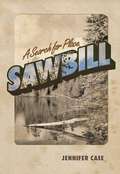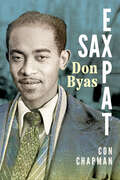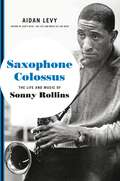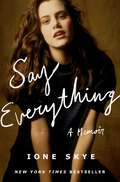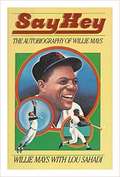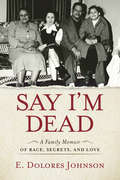- Table View
- List View
Saving Sara: A Memoir of Food Addiction
by Sara SomersFor nearly fifty years, Sara Somers suffered from untreated food addiction. In this brutally honest and intimate memoir, Somers offers readers an inside view of a food addict&’s mind, showcasing her experiences of obsessive cravings, compulsivity, and powerlessness regarding food. Saving Sara chronicles Somers&’s addiction from childhood to adulthood, beginning with abnormal eating as a nine-year-old. As her addiction progresses in young adulthood, she becomes isolated, masking her shame and self-hatred with drugs and alcohol. Time and again, she rationalizes why this time will be different, only to have her physical cravings lead to ever-worse binges, to see her promises of doing things differently next time broken, and to experience the amnesia that she—like every addict—experiences when her obsession sets in again. Even after Somers is introduced to the solution that will eventually end up saving her, the strength of her addiction won&’t allow her to accept her disease. Twenty-six more years pass until she finally crawls on hands and knees back to that solution, and learns to live life on life&’s terms. A raw account of Somers&’s decades-long journey, Saving Sara underscores the challenges faced by food addicts of any age—and the hope that exists for them all.
Saving Sarah: Learning to live, love and laugh with ADHD
by Susy ParkerSusy Parker's daughter, Sarah, was diagnosed with ADHD and Anxiety when she was just six years old. Months later she was also diagnosed with Oppositional Defiance Disorder (ODD). Saving Sarah charts her family's rollercoaster journey from diagnosis, through the consulting rooms of various specialists, their confusion over the conflicting medical advice they received and Susy's eventual decision to quit the medications and find her own way to save her daughter and their family. I am sharing Sarah's story to let other parents know that there can be another way and that miracles do happen, because a miracle happened to us. ADHD, it's just a different way to be. - Susy I think that the Doctors don't know what they are doing. Children are really scared, and the Doctors don't know what the children are actually capable of. When they know, they will see that they are beautiful children, and they don't need medication. - Sarah * Names have been changed to protect identity
Saving Sarah: One Mother's Battle Against the Health Care System to Save Her Daughter's Life
by Janet MurnaghanWhen her daughter desperately needed a lung transplant to survive, Janet Murnaghan rallied against the outdated restrictions in healthcare that would limit her daughter's options.Sarah had been dying of cystic fibrosis since the day she was born. The disease quickly ravaged her lungs and little body bit-by-bit. Fragile and frail, she had only weeks to live, when her mom realized the reality of Sarah’s situation: transplant laws, restricting access to lungs based on arbitrary age restrictions, meant Sarah’s options were limited. The injustice of her daughter’s fate spurred Janet to start a public battle against outdated health care regulations and a battle to save Sarah’s life. Janet transformed her pain and desperation into a voice for Sarah and other kids using social media to broadcast the unfairness, which was robbing Sarah of her right to life with the help of friends and family who emerged as Sarah’s army. How does a family navigate catastrophic illness and life in a hospital, while still maintaining a sense of normalcy? Saving Sarah is a story of hope and courage, and a mother’s determination to never give up. It's also the story of how a family—Janet and her husband Fran have four other children—reacts and adjusts when one of its members is in ongoing crisis.“I need to fight, and I cannot fight and fall apart at the same time. Each single moment is all that matters.” —from Saving Sarah
Saving Simon
by Jon KatzIn this heartfelt, thoughtful, and inspiring memoir, New York Times bestselling author Jon Katz tells the story of his beloved rescue donkey, Simon, and the wondrous ways that animals make us wiser and kinder people. In the spring of 2011, Jon Katz received a phone call that would challenge every idea he ever had about mercy and compassion. An animal control officer had found a neglected donkey on a farm in upstate New York, and she hoped that Jon and his wife, Maria, would be willing to adopt him. Jon wasn't planning to add another animal to his home on Bedlam Farm, certainly not a very sick donkey. But the moment he saw the wrenching sight of Simon, he felt a powerful connection. Simon touched something very deep inside of him. Jon and Maria decided to take him in. Simon's recovery was far from easy. Weak and malnourished, he needed near constant care, but Jon was determined to help him heal. As Simon's health improved, Jon would feed him by hand, read to him, take him on walks, even confide in him like an old and trusted friend. Then, miraculously, as if in reciprocation, Simon began to reveal to Jon the true meaning of compassion, the ways in which it can transform our lives and inspire us to take great risks. This radically different perspective on kindness and empathy led Jon to a troubled border collie from Ireland in need of a home, a blind pony who had lived outside in a pasture for fifteen years, and a new farm for him and Maria. In the great tradition of heroes--from Don Quixote to Shrek--who faced the world in the company of their donkeys, Jon came to understand compassion and mercy in a new light, learning to open up "not just to Simon, not just to animals, but to the human experience. To love, to risk, to friendship." With grace, warmth, and keen emotional insight, Saving Simon plumbs the depths of the bonds we form with our animals, and the rewards of "living a more compassionate, considered, and meaningful life." Praise for Jon Katz "With wisdom and grace, Katz unlocks the canine soul and the complicated wonders that lie within and offers powerful insights to anyone who has ever struggled with, and loved, a troubled animal."--John Grogan, author of Marley & Me "Katz's world--of animals and humans and their combined generosity of spirit--is a place you're glad you've been."--The Boston Globe "From Toto to Marley, our canine friends are a sure bet in the literary biz. But no one seems to speak their language like Jon Katz."--San Antonio Express-News "Katz proves himself a Thoreau for modern times as he ponders the relationships between man and animals, humanity and nature."--Fort Worth Star-Telegram "I toss a lifetime award of three liver snaps to Jon Katz."--Maureen Corrigan, National Public Radio's Fresh AirFrom the Hardcover edition.
Saving Sin City: William Travers Jerome, Stanford White, And The Original Crime Of The Century
by Mary CummingsAn operatic story of jealousy, obsession, vast fortunes, and moral crusaders set against the glittering backdrop of Gilded Age New York City. When Stanford White, one of the most famous architects of the era—whose mark on New York City is second to none—was murdered by Harry K. Thaw in 1906, his death become known as “The Crime of the Century.” But there were other players in this love triangle gone wrong that would play a part in the incredible story of White’s murderer. Chief among them was the ambitious district attorney William Travers Jerome, who had the opportunity to make—or break—his career with his prosecution of Thaw. Award-winning journalist Mary Cummings reveals a new angle to this incredible crime through Jerome’s story—a story that is ripe for our post-“Serial” era. Thaw was the debauched and deranged heir to a Pittsburgh fortune who had a sadistic streak. White was an artistic genius and one of the world’s premier architects who would become obsessed with a teenaged chorus girl, Evelyn Nesbit. White preyed on Nesbit, who, in a surprising twist, also became a fixation for Thaw. Nesbit and Thaw would later marry, but Thaw’s lingering jealousy and anger toward White over his past history with Nesbit would explosively culminate in White’s shocking murder—and the even more shocking trial of Thaw for a murder that was committed in front of dozens of eye witnesses. The promising young D.A. would find his faith in himself and the law severely tested as he battled colorful crooks, licentious grandees, and corrupt politicians. Cummings brilliant reveals the social issues simmering below the surface of New York that Jerome had to face. Filled with mesmerizing drama, rich period details, and fascinating characters, Saving Sin City sheds fresh light on crimes whose impact still echoes throughout the twenty-first century.
Saving Tarboo Creek: One Family’s Quest to Heal the Land
by Scott Freeman Susan Leopold Freeman“A moving account of a beautiful project. We need stories of healing in this tough moment; this is a particularly fine one.” —Bill McKibben, author of Radio Free Vermont When the Freeman family decided to restore a damaged creek in Washington’s Olympic Peninsula—to transform it from a drainage ditch into a stream that could again nurture salmon— they knew the task would be formidable and the rewards plentiful. In Saving Tarboo Creek, Scott Freeman artfully blends his family’s story with powerful universal lessons about how we can all live more constructive, fulfilling, and natural lives by engaging with the land rather than exploiting it. Equal parts heartfelt and empowering, this book explores how we can all make a difference one choice at a time. In the proud tradition of Aldo Leopold’s A Sand County Almanac, Saving Tarboo Creek is both a timely tribute to our land and a bold challenge to protect it.
Saving Yellowstone: Exploration and Preservation in Reconstruction America
by Megan Kate NelsonFrom historian and critically acclaimed author of The Three-Cornered War comes the propulsive and vividly told story of how Yellowstone became the world&’s first national park amid the nationwide turmoil and racial violence of the Reconstruction era.Each year nearly four million people visit Yellowstone National Park—one of the most popular of all national parks—but few know the fascinating and complex historical context in which it was established. In late July 1871, the geologist-explorer Ferdinand Hayden led a team of scientists through a narrow canyon into Yellowstone Basin, entering one of the last unmapped places in the country. The survey&’s discoveries led to the passage of the Yellowstone Act in 1872, which created the first national park in the world. Now, author Megan Kate Nelson examines the larger context of this American moment, illuminating Hayden&’s survey as a national project meant to give Americans a sense of achievement and unity in the wake of a destructive civil war. Saving Yellowstone follows Hayden and two other protagonists in pursuit of their own agendas: Sitting Bull, a Lakota leader who asserted his peoples&’ claim to their homelands, and financier Jay Cooke, who wanted to secure his national reputation by building the Northern Pacific Railroad through the Great Northwest. Hayden, Cooke, and Sitting Bull staked their claims to Yellowstone at a critical moment in Reconstruction, when the Grant Administration and the 42nd Congress were testing the reach and the purpose of federal power across the nation. A narrative of adventure and exploration, Saving Yellowstone is also a story of Indigenous resistance, the expansive reach of railroad, photographic, and publishing technologies, and the struggles of Black southerners to bring racial terrorists to justice. It reveals how the early 1870s were a turning point in the nation&’s history, as white Americans ultimately abandoned the the higher ideal of equality for all people, creating a much more fragile and divided United States.
Saving the Countryside: The Story of Beatrix Potter and Peter Rabbit
by Linda MarshallWorld Magazine's Picture Book of the Year 2020"Fans of Beatrix Potter will delight in this tribute to her dedication and talent, encapsulating a legacy that reaches far beyond the pages of her beloved books."-Foreword Reviews in a STARRED REVIEW"Empowering and fresh."-School Library Journal"The life of the British picture-book author and illustrator makes a serendipitous subject for an engaging and attractive picture book...A well-told tale that makes the life story of the renowned author accessible to children."-Kirkus Reviews "Perhaps Peter Rabbit needs no introduction, but even children who know Beatrix Potter's name probably know little about her. This appealing picture book fills that gap.... Recommended for young Beatrix Potter fans."-Booklist"In forthright language, this picture book biography recounts her boundary-breaking life as she grows from a nature-loving child with a menagerie of pets...into a successful artist and canny entrepreneur. An attractive introduction to an iconic creator."-Publisher's Weekly"An exceptionally accurate portrait of Beatrix Potter told with humor and surprise. Beautifully done." Linda Lear, author of Beatrix Potter: A Life in NatureThrough she's universally known as the creator of The Tale of Peter Rabbit, Beatrix Potter did so much more. This is the true story about how she helped save the English countryside!Growing up in London, Beatrix Potter felt the restraints of Victorian times. Girls didn't go to school and weren't expected to work. But she longed to do something important, something that truly mattered. As Beatrix spent her summers in the country and found inspiration in nature, it was through this passion that her creativity flourished. There, she crafted The Tale of Peter Rabbit. She would eventually move to the countryside full-time, but developers sought to change the land. To save it, Beatrix used the money from the success of her books and bought acres and acres of land and farms to prevent the development of the countryside that both she and Peter Rabbit so cherished. Because of her efforts, it's been preserved just as she left it.This beautiful picture book shines a light on Beatrix Potter's lesser-known history and her desire to do something for the greater good.
Saving the Last Rhinos: The Life Of A Frontline Conservationist
by Graham Spence Grant FowldsThe remarkable story of Grant Fowlds, who has dedicated his life to saving the imperiled rhinos, vividly told with Graham Spence, co-author of the bestselling The Elephant Whisperer.What would drive a man to &‘smuggle&’ rhino horn back into Africa at great risk to himself? This is just one of the situations Fowlds has put himself in as part of his ongoing fight against poaching, in order to prove a link between southern Africa and the illicit, lucrative trade in rhino horn in Vietnam. Shavings of rhino horn are sold as a snake-oil &“cures,&” but a rhino&’s horn has no magical, medicinal properties whatsoever. Yet it is for this that rhinoceroses are being killed at an escalating rate that puts the survival of the species in jeopardy. This corrupt, illegal war on wildlife has brought an iconic animal to the brink of extinction. Growing up on a farm in the eastern Cape of South Africa, Grant developed a deep love of nature, turning his back on hunting to focus on saving wildlife of all kinds and the environment that sustains both them and us. He is a passionate conservationist who puts himself on the front line of protecting rhinos in the wild—right now, against armed poachers—and in the long term, through his work with schoolchildren, communities, and policymakers.
Saving the Last Rhinos: The Life of a Frontline Conservationist
by Graham Spence Grant Fowlds'A terrific read . . . an outstanding book!'Gary Player and Vivienne Player'A truly heart-wrenching story, but a must-read for all who value our wild animals and their right to roam free. Grant Fowlds is a Zulu in a white skin and loves the people who hold the key to animal conservation. This is an intriguing true story that sends a clear message to the rest of the world.'Phil Liggett'Exceptionally readable - a fluid and captivating story . . . a swashbuckling tale.'Dr Dave Cooper, Rhinos Without Borders veterinarian, and Debbie Cooper of iSimangaliso Wetland Park'A rollicking true-life adventure that celebrates rhinos and people'Guy Rogers, Daily Herald'Truly awe-inspiring . . . Read this book. You will get a sense of Africa like never before, from a true African soul.'David S. Lee, Limbani in the blockbuster movie Black Panther'An excellent read . . . both sobering and uplifting'Moira Smith, General Manager Africa & Middle East, Goway TravelWhat would drive a man to 'smuggle' rhino horn back into Africa at great risk to himself? This is just one of the situations Grant Fowlds has put himself in as part of his ongoing fight against poaching, in order to prove a link between southern Africa and the illicit, lucrative trade in rhino horn in Vietnam.Shavings of rhino horn are sold as a snake-oil 'cure' for colds or impotence, but a rhino's horn has no magical, medicinal properties. It is for this that rhinoceroses are being killed at an escalating rate that puts the survival of the species in jeopardy. This corrupt, illegal war on wildlife has brought an iconic animal to the brink of extinction.Growing up on a farm in the Eastern Cape of South Africa, Grant developed a deep love of nature, turning his back on hunting to focus on saving wildlife of all kinds and the environment that sustains both them and us. He is a passionate conservationist who puts himself on the front line of protecting rhinos in the wild - right now, against armed poachers; but in the longer term, too, through his work with schoolchildren, communities and policymakers.We are most grateful to photographer Gerhard van der Westhuizen for the use of his stunning photograph on the cover of the book.
Saving the Last Rhinos: The Life of a Frontline Conservationist
by Graham Spence Grant FowldsThe remarkable story of Grant Fowlds, a conservationist who has dedicated his life to saving the last rhinos, vividly told with the help of Graham Spence, co-author of the bestselling The Elephant Whisperer.'A terrific read . . . an outstanding book!'Gary Player and Vivienne Player'A truly heart-wrenching story, but a must-read for all who value our wild animals and their right to roam free. Grant Fowlds is a Zulu in a white skin and loves the people who hold the key to animal conservation. This is an intriguing true story that sends a clear message to the rest of the world.'Phil Liggett'Exceptionally readable - a fluid and captivating story . . . a swashbuckling tale.'Dr Dave Cooper, Rhinos Without Borders veterinarian, and Debbie Cooper of iSimangaliso Wetland Park'A rollicking true-life adventure that celebrates rhinos and people'Guy Rogers, Daily Herald'Truly awe-inspiring . . . Read this book. You will get a sense of Africa like never before, from a true African soul.'David S. Lee, Limbani in the blockbuster movie Black Panther'An excellent read . . . both sobering and uplifting'Moira Smith, General Manager Africa & Middle East, Goway TravelWhat would drive a man to 'smuggle' rhino horn back into Africa at great risk to himself? This is just one of the situations Grant Fowlds has put himself in as part of his ongoing fight against poaching, in order to prove a link between southern Africa and the illicit, lucrative trade in rhino horn in Vietnam.Shavings of rhino horn are sold as a snake-oil 'cure' for colds or impotence, but a rhino's horn has no magical, medicinal properties. It is for this that rhinoceroses are being killed at an escalating rate that puts the survival of the species in jeopardy. This corrupt, illegal war on wildlife has brought an iconic animal to the brink of extinction.Growing up on a farm in the Eastern Cape of South Africa, Grant developed a deep love of nature, turning his back on hunting to focus on saving wildlife of all kinds and the environment that sustains both them and us. He is a passionate conservationist who puts himself on the front line of protecting rhinos in the wild - right now, against armed poachers; but in the longer term, too, through his work with schoolchildren, communities and policymakers.We are most grateful to photographer Gerhard van der Westhuizen for the use of his stunning photograph on the cover of the book.
Saving the Last Rhinos: The Life of a Frontline Conservationist
by Graham Spence Grant Fowlds'A terrific read . . . an outstanding book!'Gary Player and Vivienne Player'A truly heart-wrenching story, but a must-read for all who value our wild animals and their right to roam free. Grant Fowlds is a Zulu in a white skin and loves the people who hold the key to animal conservation. This is an intriguing true story that sends a clear message to the rest of the world.'Phil Liggett'Exceptionally readable - a fluid and captivating story . . . a swashbuckling tale.'Dr Dave Cooper, Rhinos Without Borders veterinarian, and Debbie Cooper of iSimangaliso Wetland Park'A rollicking true-life adventure that celebrates rhinos and people'Guy Rogers, Daily Herald'Truly awe-inspiring . . . Read this book. You will get a sense of Africa like never before, from a true African soul.'David S. Lee, Limbani in the blockbuster movie Black Panther'An excellent read . . . both sobering and uplifting'Moira Smith, General Manager Africa & Middle East, Goway TravelWhat would drive a man to 'smuggle' rhino horn back into Africa at great risk to himself? This is just one of the situations Grant Fowlds has put himself in as part of his ongoing fight against poaching, in order to prove a link between southern Africa and the illicit, lucrative trade in rhino horn in Vietnam.Shavings of rhino horn are sold as a snake-oil 'cure' for colds or impotence, but a rhino's horn has no magical, medicinal properties. It is for this that rhinoceroses are being killed at an escalating rate that puts the survival of the species in jeopardy. This corrupt, illegal war on wildlife has brought an iconic animal to the brink of extinction.Growing up on a farm in the Eastern Cape of South Africa, Grant developed a deep love of nature, turning his back on hunting to focus on saving wildlife of all kinds and the environment that sustains both them and us. He is a passionate conservationist who puts himself on the front line of protecting rhinos in the wild - right now, against armed poachers; but in the longer term, too, through his work with schoolchildren, communities and policymakers.We are most grateful to photographer Gerhard van der Westhuizen for the use of his stunning photograph on the cover of the book.
Saving the Schindler's Daughter: How Courageous Women Rescued an Orphaned Girl from French Concentration Camps
by Douglas BoydLore Schindler was ten years old when her dentist father Harry was arrested by the Gestapo in Berlin and sent to Sachsenhausen concentration camp. His wife Grete bought his release by giving all their possessions to the Nazi state. Leaving Germany with just 10 Marks each, parents and daughter suffered humiliating strip searches at the border. This was the start of Lore’s ordeal. In her first French concentration camp, her mother died. Her father also died in another camp. Orphaned and ill in the huge camp at Gurs, she was saved by prisoner-nurse Schwester Käte, but would later have starved to death, had not two sisters – Elsie and Marthe Liefmann – ‘adopted’ her, found food and made her eat it. Elsbeth Kasser was a Swiss-German social worker in the camp who gave her treats of milk and Swiss cheese to build up ‘the thinnest girl in the camp’. Another social worker, Elisabeth Hirsch used a forged identity card to get Lore out of the camp and took her to La Maison de Moissac, a children’s home in SW France run by her sister Shatta Simon. There, several hundred refugee children were hidden from the Nazi occupiers and French fascists who wanted to send the children to the death camps in Poland. When it became unsafe to stay in Moissac, Lore was adopted by pianist Hélène Gribenski, living in a remote village. When that too became unsafe, she moved her little family into a primitive hovel in the forest to await the Allied victory. That Lore survived was due to these courageous women, who risked their own lives to save hers. After the war, she found love in an Israeli kibbutz and moved with her American husband to New York, becoming a librarian with Brooklyn Public Library. No borrowers ever guessed what her adolescence and burgeoning womanhood had been like in a terrifying land whose language she could not even speak.
Saving the Sun: How Wall Street Mavericks Shook Up Japan's Financial World and Made Billions
by Gillian TettSaving the Sun tells the story of the world's largest private equity deal where American investors made billions of dollars rehabilitating Shinsei, a failed Japanese bank. Within that business saga is the dramatic tale of Japan's brightest financial minds, the men who made the Japanese economic miracle come to life, and their struggle against the economic failure in the 1990s. Into this climate of despair, where Japan seemed incapable of reviving prosperity, came a group of wily and determined Americans who would discover just how different the Japanese really are.
Saving the White Lions: One Woman's Battle for Africa's Most Sacred Animal
by Andrew Harvey Linda TuckerIn this captivating, suspenseful memoir, white lion conservationist Linda Tucker describes her perilous struggle to protect the sacred white lion from the merciless and mafia-like trophy-hunting industry, armed only with her indomitable spirit and total devotion. Her story begins in 1991 with a heart-stopping misadventure in the Timbavati Reserve of South Africa. Tucker--then a successful advertising executive--and a group of fellow travelers found themselves surrounded by a pride of angry lions. There was no way out, night had fallen, and the battery in their only flashlight was beginning to flicker. Miraculously, a local medicine woman, with two youngsters in tow, passed, trancelike and fearless, through the lions and escorted them all to safety. For Tucker, that life-threatening experience became a life-changing one. She abandoned her career, left Europe, and returned to Timbavati to track down the medicine woman who had saved her: Maria Khosa. Upon seeing Tucker again, Khosa only smiled and said, "What took you so long?" She had been expecting her, and there was so much to do. Under Khosa's shamanic tutelage, Tucker learned of her sacred destiny: to be the "keeper of the white lions," believed to be angelic beings sent to Earth to save humanity at a time of crisis. Khosa also prophesized that the queen of the white lions--the embodiment of the mother of Ra, the sun god--would soon be born, on a day and in a place considered holy by Westerners. On December 25, 2000, in the little South Africa town of Bethlehem, a snowy white lion cub, Marah, was born. From the moment of her first meeting with Marah, Tucker's story immediately takes off into battle, as she dedicates her every waking moment to prying Marah and her siblings from the grips of the trophy-hunting industry. Compellingly written in the intimate style of a journal, Tucker describes with unflinching honesty her fears, doubts, hopes, and dreams, all the while unfolding for us an unforgettable tale of adventure, romance, spirituality, and most of all, justice.
Saving: A Doctor’s Struggle to Help His Children
by Shane Neilson“ Shane Neilson is a brilliant writer and his work deserves to be better known. There hasn' t been such a poignant and harrowing memoir of fatherhood in Canada since Ian Brown' s The Boy in The Moon.” – Karen Connelly, author of The Change RoomWhen his two-year-old son develops epilepsy, Shane Neilson and his wife, Janet, struggle to obtain timely care for him while at the same time navigating their young daughter' s diagnosis of childhood depression. His family' s journey through a sometimes inadequate and often uncaring medical system is informed by Shane' s personal history of bipolar disorder and his professional experience with disability as a practicing physician.
Savita: The Tragedy that shook a nation
by Kitty HollandSeventeen weeks pregnant and facing a miscarriage, Savita Halappanavar and her husband Praveen walked into an Irish maternity ward in October 2012. Unwittingly, the couple also walked into that deeply controversial arena in which Ireland’s legislative position on abortion remained unresolved.A week later, Savita was dead from septicaemia. Reports of her death and of the refusal to allow Savita a termination of her pregnancy sent shockwaves across Ireland and around the world. Once again the subject of abortion was catapulted to the very top of the agenda in Ireland. With the pro-life and pro-choice camps claiming the moral high ground, both sides in the bitterly contested battle sought to appropriate Savita’s story and her image. In the midst of the ensuing rage and furore, the marches and protests, the threats and counter-threats that exploded across political and media platforms, Savita and the complete circumstances of her death were lost. In Savita: The Tragedy That Shook A Nation, Kitty Holland addresses this imbalance as she reveals the truth behind the headlines and explores many unanswered questions: Who was Savita? How significant was it that she was a non-Irish, non-Catholic woman in search of help on Irish soil? And how did her husband and her community’s reaction to her death shape the parameters of the debate which followed? Holland’s exposé also looks at how the tragic circumstances of Savita’s death played a part in compelling the Irish Government to finally legislate on abortion and how activists on each side succeeded or failed in shaping that legislation.
Savor: A Chef's Hunger for More
by Fatima AliA young chef whose dreams were cut short savors every last minute as she explores food and adventure, illness and mortality in Savor, an &“inspiring&” (The New York Times Book Review) memoir and family story that sweeps from Pakistan to Manhattan and beyond. &“Ali&’s strength and passion for food and her culture shines through. . . . This memoir is a tribute to the extraordinary life and impact she made in twenty-nine years.&”—Oprah Daily (20 of the Best Fall Nonfiction Books of 2022)Fatima Ali won the hearts of viewers as the Fan Favorite of Bravo&’s Top Chef in season fifteen. Twenty-nine years old, she was a dynamic, boundary-breaking chef and a bright new voice for change in the food world. After the taping wrapped and before the show aired, Fati was diagnosed with a rare form of bone cancer. Not one to ever slow down or admit defeat, the star chef vowed to spend her final year traveling the world, eating delicious food, and making memories with her loved ones. But when her condition abruptly worsened, her plans were sidelined. She pivoted, determined to make her final days count as she worked to tell the story of a brown girl chef who set out to make a name for herself, her food, and her culture. Including writing from Fatima during her last months and contributions by her mother, Farezeh, and her collaborator, Tarajia Morrell, Savor is a deftly woven account and an inspiring ode to the food, family, and countries Fatima loved so much. Alternating between past and present, readers are transported back to Pakistan and the childhoods of both Fatima and Farezeh, each deeply affected by cultural barriers that shaped the course of their lives. From the rustic stalls of the outdoor markets of Karachi to the kitchen and dining room of Meadowood, the acclaimed three-star Michelin restaurant where she apprenticed, Fati reflects on her life and her identity as a chef, a daughter, and a queer woman butting up against traditional views. Savor is a triumphant memoir, at once an exploration of the sense of wonder that made Fatima so special and a shining testament to the resilience of the human spirit. At its core, it is a story about what it means to truly live, a profound and exquisite portrait of savoring every moment.
Sawbill: A Search for Place
by Jennifer CaseIn Sawbill Jennifer Case watches her family suddenly exchange their rooted existence for a series of relocations that take them across the United States. In response Case struggles to &“live in place&” without a geographical home, a struggle that leads her to search for grounding in the now-dismantled fishing resort her grandparents ran in northeastern Minnesota. By chronicling her migratory adulthood alongside the similarly unpredictable history of Sawbill Lodge, this memoir offers a resonant meditation on home, family, environment, and the human desire for place in the inherently mobile twenty-first century.
Sawdusted: Notes from a Post-Boom Mill
by Raymond GoodwinWhen Raymond Goodwin started work at a Michigan sawmill in 1979, the glory days of lumbering were long gone. But the industry still had a faded glow that, for a while, held him there. InSawdustedGoodwin wipes the dust off his memories of the rundown, nonunion mill where he toiled for twenty months as a two-time college dropout. Spare, evocative character sketches bring to life the personalities of his fellow millworkers-their raucous pranks, ribbing, complaints about wages and weather, macho posturing, failed romances, and fantasies of escape. The result is a mostly funny, sometimes heartbreaking portrait of life in the lumbering industry a century after its heyday. Amidst the intermittent anger and resignation of poorly paid lumbermen in the Great Lakes hinterlands, Goodwin reveals moments of vulnerability, generosity, and pride in craftsmanship. It is a world familiar, in its basic outlines, to anyone who has ever done manual labor. At the heart of the book is a coming-of-age story about Goodwin’s relationship with his older brother Randy-a heavy drinker, chain smoker, and expert sawyer. Gruff but kind, Randy tutors Raymond in the ways of the blue-collar world even as he struggles with the demons that mask his own melancholy. A 2010 Michigan Notable Book
Sax Expat: Don Byas (American Made Music Series)
by Con ChapmanDon Byas (1913–1972) may be lesser known than the counterparts he played with—Count Basie, Duke Ellington, and Dizzy Gillespie, among others—but he was an enigma. He never stayed with a band for long, and eventually went solo partly to make more money and partly due to his inability to work with bandleaders. Often drinking to excess, alcohol fueled his sometimes-erratic behavior on and off the bandstand. He went through at least thirteen different groups in fifteen years of professional play before leaving for Europe in 1946. Despite his fractious personality, in Europe he found peace and contentment as a family man in the Netherlands, where he lived out his days with his second wife and their four children. He learned at least seven languages during his years in Europe, and on traveling to a new country could pick up a few phrases in short order, soon speaking to the locals and even composing songs in their native tongue. In Sax Expat: Don Byas, author Con Chapman argues that Byas’s relative obscurity arises from his choice to live in Europe, where he missed out on recording opportunities and exposure in the US that would have made him renowned and wealthier. His numerous achievements, including his solo on Count Basie’s “Harvard Blues,” which is a model of restrained invention; his interpretation of the sentimental movie theme “Laura”; and his duets with bassist Slam Stewart were included in the Smithsonian Collection of Classic Jazz and secured Byas’s place in jazz history. This biography brings to life an amazing jazz story.
Saxophone Colossus: The Life and Music of Sonny Rollins
by Aidan Levy**Winner of the American Book Award (2023)** **Longlisted for the PEN/Jacqueline Bograd Weld Award (2023)** The long-awaited first full biography of legendary jazz saxophonist and composer Sonny Rollins Sonny Rollins has long been considered an enigma. Known as the &“Saxophone Colossus,&” he is widely acknowledged as one of the greatest jazz improvisers of all time, winning Grammys, the Austrian Cross of Honor, Sweden&’s Polar Music Prize and a National Medal of Arts. A bridge from bebop to the avant-garde, he is a lasting link to the golden age of jazz, pictured in the iconic &“Great Day in Harlem&” portrait. His seven-decade career has been well documented, but the backstage life of the man once called &“the only jazz recluse&” has gone largely untold—until now. Based on more than 200 interviews with Rollins himself, family members, friends, and collaborators, as well as Rollins&’ extensive personal archive, Saxophone Colossus is the comprehensive portrait of this legendary saxophonist and composer, civil rights activist and environmentalist. A child of the Harlem Renaissance, Rollins&’ precocious talent landed him on the bandstand and in the recording studio with Bud Powell, Thelonious Monk, Charlie Parker, Miles Davis and Dizzy Gillespie, or playing opposite Billie Holiday. An icon in his own right, he recorded Tenor Madness, featuring John Coltrane; Way Out West; Freedom Suite, the first civil rights-themed album of the hard bop era; A Night at the Village Vanguard; and the 1956 classic Saxophone Colossus. Yet his meteoric rise to fame was not without its challenges. He served two sentences on Rikers Island and won his battle with heroin addiction. In 1959, Rollins took a two-year sabbatical from recording and performing, practicing up to 16 hours a day on the Williamsburg Bridge. In 1968, he left again to study at an ashram in India. He returned to performing from 1971 until his retirement in 2012. The story of Sonny Rollins—innovative, unpredictable, larger than life—is the story of jazz itself, and Sonny&’s own narrative is as timeless and timely as the art form he represents. Part jazz oral history told in the musicians&’ own words, part chronicle of one man&’s quest for social justice and spiritual enlightenment, this is the definitive biography of one of the most enduring and influential artists in jazz and American history.
Say Everything: A Memoir
by Ione SkyeINSTANT <b>NEW YORK TIMES BESTSELLER</b> <p> Gen X icon Ione Skye bares all in an achingly vulnerable coming-of-age memoir about chasing fame, desire, and true love in the shadow of her famous, absent father. <p> In 1987, sixteen-year-old Ione Skye landed the breakout role of Diane Court, the dream girl who inspires John Cusack’s iconic boombox serenade in the hit Cameron Crowe film, Say Anything. While Skye seemed perfectly typecast as an aloof valedictorian, she was anything but. Deserted by her dad, the folk singer legend Donovan, Skye was a ninth-grade dropout who sought solace and validation in the eyes of audiences and dreamy costars like Keanu Reeves, River Phoenix, Matthew Perry, John Cusack, and Robert Downey Jr. But like her sixties It Girl mom, Skye’s greatest weakness was musicians. <p> On the heels of a toxic relationship with the Red Hot Chili Peppers’ Anthony Kiedis, which began when she was just sixteen and he was twenty-four, the actress leapt into wedded bliss with her first great love, Beastie Boy Adam Horovitz. But marriage was not the magical hall pass to adulthood Skye had imagined. Awakening to her bisexuality and desperately insecure, she risked her fairytale marriage for a string of affairs with gorgeous nineties “bad girls.” The dream marriage imploded, and Skye’s trust in herself and her future along with it. <p> Set against a backdrop of rock royalty compounds, supermodel cliques, and classic late-century films like River’s Edge, Gas Food Lodging, and Wayne’s World, Say Everything is a wild ride of Hollywood thrills as well as a lyrical reflection on ambition, intimacy, and a messy, sexy, unconventional life. <b>New York Times Bestseller</b>
Say Hey: The Autobiography of Willie Mays
by Willie Mays Lou SahadiThe legendary athlete discusses his greatest plays, his greatest teammates and opponents, his personal life, his days in the Negro Leagues, contemporary baseball, and his most bitter moment in major league baseball.
Say I'm Dead: A Family Memoir of Race, Secrets, and Love
by E. Dolores JohnsonSay I'm Dead is the true story of family secrets, separation, courage, and trans-formation through five generations of interracial relationships. Fearful of prison time—or lynching—for violating Indiana's antimiscegenation laws in the 1940s, E. Dolores Johnson's black father and white mother fled Indianapolis to secretly marry in Buffalo, New York. When Johnson was born, social norms and her government-issued birth certificate said she was Negro, nullifying her mother's white blood in her identity. Later, as a Harvard-educated business executive feeling too far from her black roots, she searched her father's black genealogy. But in the process, Johnson suddenly realized that her mother's whole white family was—and always had been—missing. When she began to pry, her mother's 36-year-old secret spilled out. Her mother had simply vanished from Indiana, evading an FBI and police search that had ended with the conclusion that she had been the victim of foul play.
